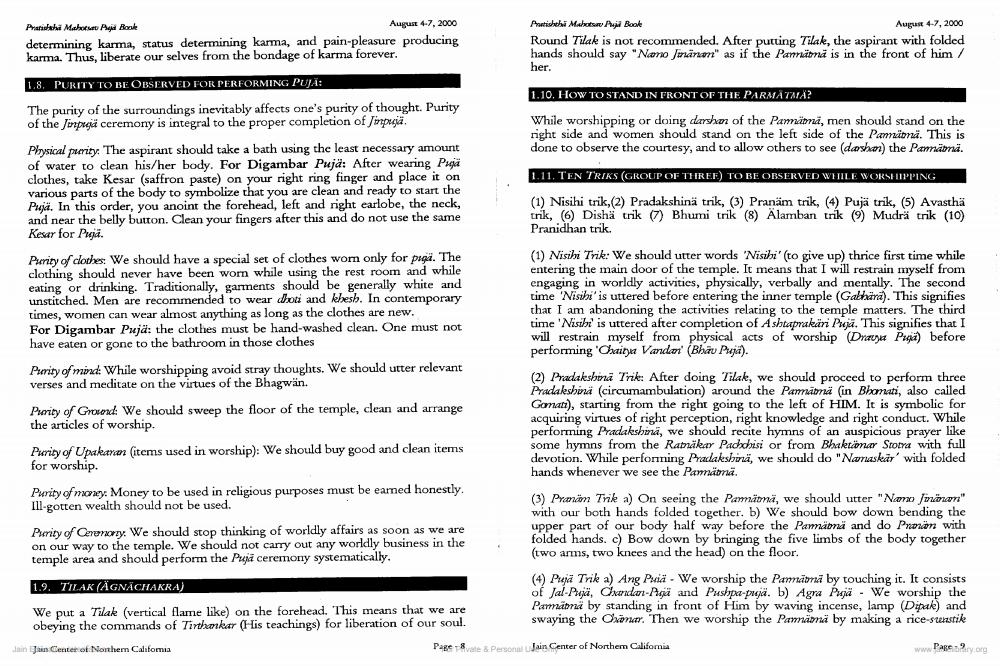Book Title: Puja Book Author(s): Publisher: USA Jain Center Northern Calfornia View full book textPage 5
________________ Pratishtha Mahotsav Paja Book August 4-7, 2000 determining karma, status determining karma, and pain-pleasure producing karma. Thus, liberate our selves from the bondage of karma forever. 1.8. PURITY TO BE OBSERVED FOR PERFORMING PUJĂ: The purity of the surroundings inevitably affects one's purity of thought. Purity of the Jinpuja ceremony is integral to the proper completion of Jinpuja. Physical purity. The aspirant should take a bath using the least necessary amount of water to clean his/her body. For Digambar Pujä: After wearing Pä clothes, take Kesar (saffron paste) on your right ring finger and place it on various parts of the body to symbolize that you are clean and ready to start the Puja. In this order, you anoint the forehead, left and right earlobe, the neck, and near the belly button. Clean your fingers after this and do not use the same Kesar for Puja. Purity of clothes: We should have a special set of clothes worn only for piga. The clothing should never have been worn while using the rest room and while eating or drinking. Traditionally, garments should be generally white and unstitched. Men are recommended to wear dhoti and khesh. In contemporary times, women can wear almost anything as long as the clothes are new. For Digambar Pujä: the clothes must be hand-washed clean. One must not have eaten or gone to the bathroom in those clothes Purity of mind: While worshipping avoid stray thoughts. We should utter relevant verses and meditate on the virtues of the Bhagwän. Purity of Ground: We should sweep the floor of the temple, clean and arrange the articles of worship. Purity of Upakaran (items used in worship): We should buy good and clean items for worship. Purity of money. Money to be used in religious purposes must be earned honestly. Ill-gotten wealth should not be used. Purity of Ceremony. We should stop thinking of worldly affairs as soon as we are on our way to the temple. We should not carry out any worldly business in the temple area and should perform the Puja ceremony systematically. 1.9. TILAK (ÄGNÄCHAKRA) We put a Tilak (vertical flame like) on the forehead. This means that we are obeying the commands of Tirthankar (His teachings) for liberation of our soul. Jain Jain Center of Northern California Pratishtha Mahotsav Puji Book August 4-7, 2000 Round Tilak is not recommended. After putting Tilak, the aspirant with folded hands should say "Namo Jinanam" as if the Pannänä is in the front of him/ her. 1.10. HOW TO STAND IN FRONT OF THE PARMÄTMÄ? While worshipping or doing darshan of the Pamätna, men should stand on the right side and women should stand on the left side of the Pamätnä. This is done to observe the courtesy, and to allow others to see (darshan) the Pamätä. 1.11. TEN TRIKS (GROUP OF THREE) TO BE OBSERVED WHILE WORSHIPPING (1) Nisihi trik, (2) Pradakshinä trik, (3) Pranam trik, (4) Pujä trik, (5) Avasthä trik, (6) Dishä trik (7) Bhumi trik (8) Älamban trik (9) Mudrä trik (10) Pranidhan trik. (1) Nisihi Trik: We should utter words 'Nisihi' (to give up) thrice first time while entering the main door of the temple. It means that I will restrain myself from engaging in worldly activities, physically, verbally and mentally. The second time 'Nisibi' is uttered before entering the inner temple (Gabhara). This signifies that I am abandoning the activities relating to the temple matters. The third time 'Nisiht' is uttered after completion of Ashtaprakäri Puja. This signifies that I will restrain myself from physical acts of worship (Dravya Puja) before performing 'Chaitya Vandan (Bhau Puja). (2) Pradakshina Trik: After doing Tilak, we should proceed to perform three Pradakshina (circumambulation) around the Pamätä (in Bhomati, also called Gomat), starting from the right going to the left of HIM. It is symbolic for acquiring virtues of right perception, right knowledge and right conduct. While performing Pradakshina, we should recite hymns of an auspicious prayer like some hymns from the Ramnäkar Pachohisi or from Bhaktamar Stotra with full devotion. While performing Pradakshinä, we should do "Namaskar' with folded hands whenever we see the Pamätnä (3) Pranam Trik a) On seeing the Pamätnä, we should utter "Namo Jinänam" with our both hands folded together. b) We should bow down bending the upper part of our body half way before the Pamätnä and do Proan with folded hands. c) Bow down by bringing the five limbs of the body together (two arms, two knees and the head) on the floor. (4) Puja Trik a) Ang Puiä - We worship the Pamana by touching it. It consists of Jal-Puja, Chandan-Puja and Pushpa-puja. b) Agra Puja We worship the Parmatma by standing in front of Him by waving incense, lamp (Dipak) and swaying the Chamar. Then we worship the Panama by making a rice-sunstik Page 8vate & Personal Jain Center of Northern California Pagery.org www.Page Navigation
1 ... 3 4 5 6 7 8 9 10 11
